Effective Rat Control: Proven Strategies For A Rodent-Free Home
The Importance of Rat Control
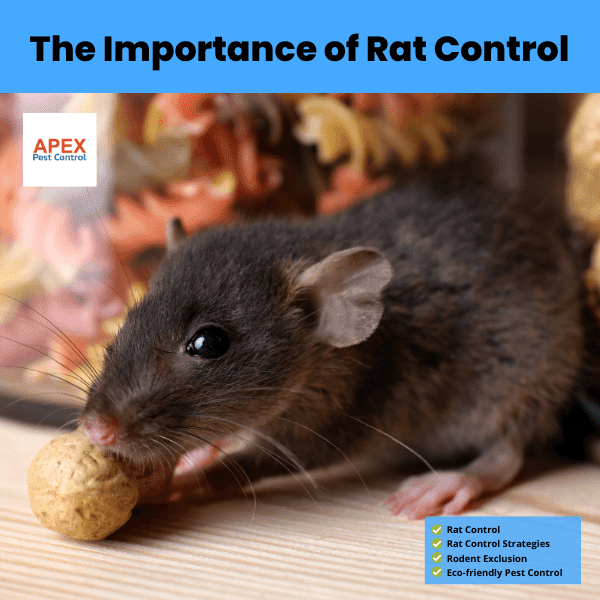
Rat control is a critical aspect of pest management that demands immediate attention from homeowners and businesses alike. These rodents, primarily of the genus Rattus, pose significant health risks and can cause extensive property damage if left unchecked.
Health Risks Posed by Rats
Rats are more than just annoying pests. They pose significant health risks to humans and pets alike. These rodents are known carriers of various diseases such as:
- Leptospirosis
- Hantavirus Pulmonary Syndrome (HPS)
- Plague
- Tularemia
- Salmonellosis
These diseases can be fatal if not treated immediately. Rats can transmit pathogens through their droppings, urine, or saliva, making any contact with these rodents potentially dangerous.
Damage Caused by Rats to Property
Apart from health concerns, rats cause considerable damage to properties as well. Their incessant gnawing habit leads them to chew on almost anything, including:
- Electrical wires (potentially causing short circuits or fires)
- Insulation materials (leading to heating inefficiencies)
- Structural components (resulting in potentially costly repairs)
The economic impact of rat infestations can be substantial, affecting both residential and commercial properties.
Discover our in-depth guide to Rat Bait Stations, featuring reliable techniques for safe, efficient, and long-lasting rodent control in your home or business.
Identifying a Rat Infestation
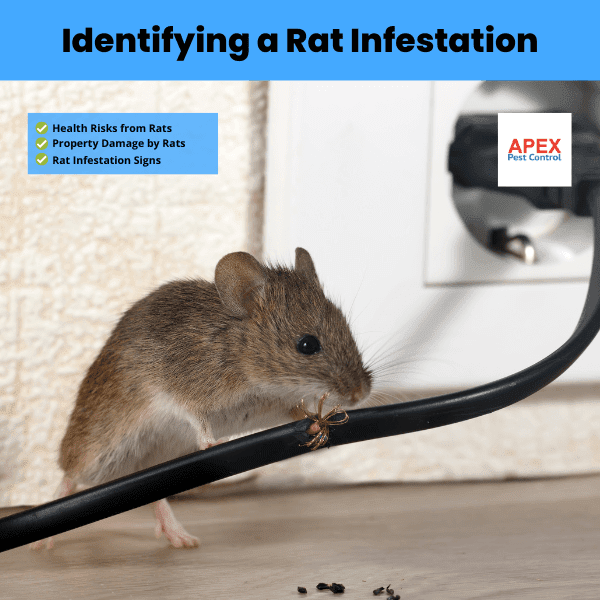
To implement effective rat control measures, one must first identify if there is an infestation present.
Signs of Rat Presence
There are several tell-tale signs indicating rat presence within your vicinity:
- Droppings or urine stains
- Gnaw marks on food containers or structures
- Tracks along pathways they frequent (dust-free areas)
- Noise from their activities, especially during the night when they’re most active
- Grease marks along walls or baseboards
Common Areas Where Rats Hide
Rats typically take shelter in secluded places that provide warmth and safety from predators while being near potential food sources. These include:
- Attics
- Basements
- Behind walls or cabinets
- Under floorboards
- In dense vegetation around buildings
Understanding rat behaviour and habitat preferences is crucial for effective control strategies.
Preventive Measures Against Rats

Rat infestations can be prevented through certain measures aimed at making our surroundings less inviting for these rodents.
Proper Waste Management
One primary source attracting rats is waste disposal areas, particularly those improperly managed ones where garbage piles up unattended for days, becoming perfect feeding grounds. Implement these strategies:
- Use sturdy, sealed garbage containers
- Regularly dispose of waste
- Keep compost bins sealed and away from structures
Sealing Entry Points
Another preventive measure involves sealing all possible entry points such as:
- Gaps around doors/windows/vents/pipes
- Cracks or holes in walls/floors
- Openings around utility lines
Use durable materials like steel wool, caulk, or metal sheeting to seal these openings.
Keeping Food Sources Out of Reach
Keeping food items properly stored and out of reach is another effective way to deter rats. This includes:
- Storing dry goods in airtight containers
- Regularly cleaning up spills and crumbs
- Keeping pet food sealed when not in use
Rat Control Methods

If preventive measures fail and you end up with a rat infestation, several control methods are available for use.
Trapping
Types of Rat Traps
There are various types of traps, each with their own pros and cons depending on the situation:
- Snap traps
- Live-catch traps
- Glue boards
- Electronic traps
Effective Use of Rat Traps
To effectively trap rats, placement is key. Ideally, set traps:
- Along known routes they frequent
- Where they’re forced to pass over the trap
- Baited with their favourite foods (fruits, nuts, meats)
Poisoning
Types of Rat Poison
Different rat poisons, or rodenticides, include:
- Anticoagulants (causing internal bleeding)
- Non-anticoagulants (leading to kidney/liver failure)
- Metal phosphides (resulting in toxic gas buildup within stomach)
Safe Use Of Rat Poison
While effective, caution must be exercised due to the potential harm not just against rats but also towards pets and humans who might accidentally ingest them. Always:
- Keep poisons out of reach from children and pets
- Wear gloves during handling and application
- Follow manufacturer’s instructions carefully
Natural Rat Repellents
Types Of Natural Repellents
There are natural repellents that can help ward off rats, such as:
- Peppermint oil (rats dislike strong smells)
- Ultrasonic devices producing high-frequency sound waves
- Predator urine (e.g., fox or coyote)
How To Use Natural Repellents
Application depends upon the type:
- Oils usually require dilution prior to spraying around areas frequented by rats
- Devices simply need proper installation following manufacturer instructions
- Predator urine can be applied around the perimeter of your property
Professional Rat Control Services

Sometimes dealing with a severe rat problem calls for professional help, especially when infestations become too large to handle on your own.
When To Call A Professional
If you notice continued rat activity despite your efforts or if infestation signs worsen, it’s high time to call a professional pest control service.
What To Expect From A Professional Service
Professional services conduct thorough inspections, identifying all infested areas and entry points, followed by a comprehensive treatment plan including:
- Customised control strategies
- Regular follow-ups
- Advice for future prevention
Long-Term Rat Control Strategies
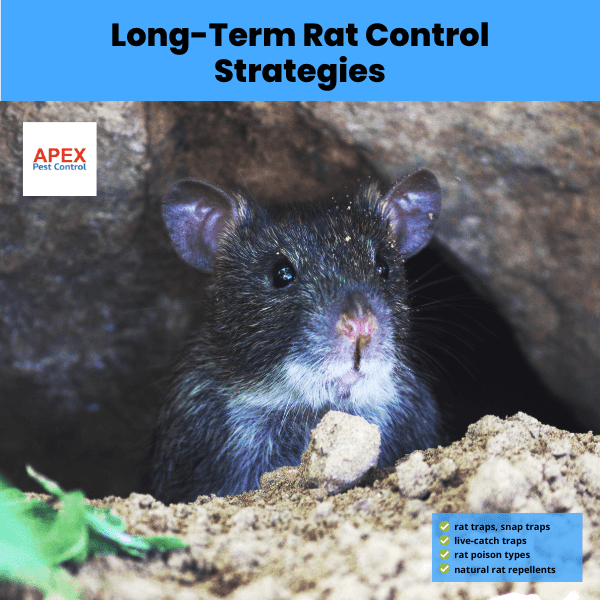
To maintain a rat-free environment in the long run involves consistent effort and strategies.
Regular Inspection And Maintenance
Conducting regular inspections and detecting early signs of infestation allows for prompt intervention. Regular maintenance includes:
- Keeping property clean and uncluttered
- Ensuring waste is properly managed and disposed
- Sealing off potential entry points
Community Involvement In Rat Control
Rat control becomes more effective when the community gets involved, with everyone practicing preventive measures, minimising the chances of these pests finding suitable habitats around the neighbourhood.
Common Myths And Misconceptions About Rats

Like any other creatures, myths surround rats, often leading to misconceptions affecting our approach towards their control.
Debunking Rat Myths
Common myths include:
- Cheese being rats’ favourite food (they actually prefer fruits, meats, and grains)
- All rats carry diseases (only specific species are known carriers)
- Rats have poor eyesight (they actually have excellent night vision)
Facts About Rats
In reality, rats possess exceptional adaptability skills, surviving in most harsh environments, making them difficult pests to manage. They are also highly intelligent and social creatures.
Technological Advancements in Rat Control

Recent innovations have revolutionised the field of rat control, offering more efficient and humane solutions.
Smart Traps and Monitoring Systems
IoT-enabled devices now allow for real-time monitoring of rat activity. These systems can:
- Capture images for rat identification
- Monitor bait levels
- Send alerts to pest control professionals
Data-Driven Pest Management
By leveraging big data and AI, pest control companies can now:
- Predict rat infestations before they occur
- Optimise bait placement strategies
- Develop more targeted and effective control methods
Environmental Considerations in Rat Control
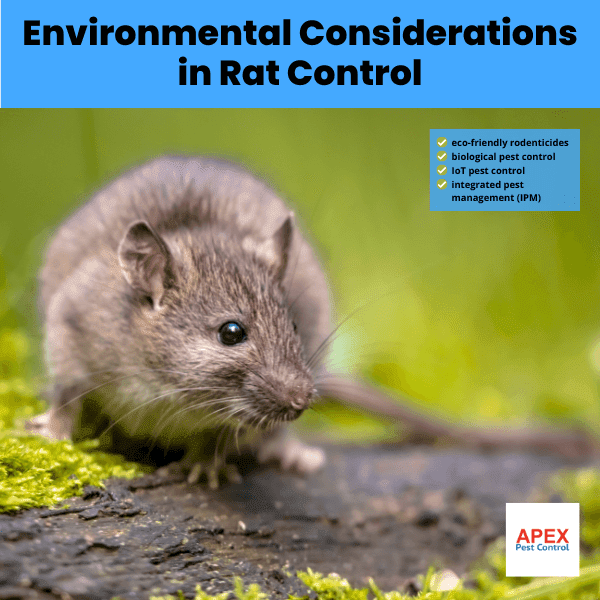
As we strive for effective rat control, it’s crucial to consider the environmental impact of our methods.
Eco-Friendly Control Methods
Integrated Pest Management (IPM) approaches focus on:
- Using non-toxic alternatives where possible
- Minimising the use of chemical pesticides
- Implementing biological control methods
Balancing Efficacy and Environmental Responsibility
The challenge lies in finding solutions that are both effective against rats and environmentally sustainable. This often involves a combination of methods and ongoing research into new, greener technologies.
Conclusion: The Importance Of Consistent Rat Control
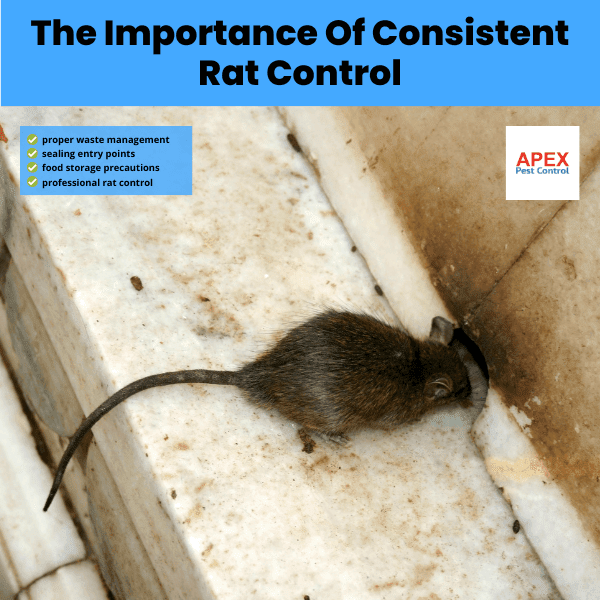
Recap Of Rat Control Methods
Effective rat management encompasses a combination of various methods involving both preventive and control measures such as:
- Proper waste management
- Sealing off entry points
- Keeping food stored securely
- Using traps, poisons, and natural repellents appropriately
- Seeking professional help when needed
Emphasising The Need For Ongoing Control Efforts
Rat control isn’t a one-time event but rather an ongoing process involving:
- Regular inspections and maintenance
- Community participation
- Staying informed about the latest control methods and technologies
By remaining vigilant and proactive, we can create environments that are less appealing for rats to thrive, ensuring healthier and safer spaces for humans and pets alike.
Frequently Asked Questions
Are all rats disease carriers?
No, not all species of rats are known to carry diseases, but certain ones like the brown rat and black rat can potentially spread numerous diseases.
What is the best food bait for a rat trap?
While specific preferences may vary depending on species, many experts recommend using fresh fruit, nuts, or peanut butter as bait in traps due to their strong smell and high caloric content.
How often should I check my traps/poisons?
This would largely depend upon the severity of the infestation; however, generally checking every 2-3 days helps monitor progress while replacing used/expired baits/poisons if necessary.
Is it safe for me/my pets around poisons/traps?
Safety always depends upon proper usage/handling. Follow instructions provided by the manufacturer carefully, especially when dealing with poisons. Keep traps and baits out of the reach of children and pets.
When do I know it’s time to call professionals?
If despite your efforts, signs persist or worsen, indicating a larger infestation than anticipated, that would be the perfect time to seek professional assistance.
How long does it typically take to eliminate a rat infestation?
The time frame can vary depending on the severity of the infestation and the methods used. It can take anywhere from a few weeks to several months for complete eradication.
Are there any eco-friendly methods for rat control?
Yes, there are several eco-friendly methods including ultrasonic repellents, natural predator scents, and non-toxic traps. However, their effectiveness may vary depending on the situation.
What should I do if I see a rat in my home or business?
Stay calm, try to identify where it came from, and immediately contact a pest control professional. In the meantime, seal off the area if possible and remove any easily accessible food sources.
By understanding these aspects of rat control and implementing a comprehensive strategy, you can effectively manage and prevent rat infestations, ensuring a safer and healthier environment.

Tony Johnson, Founder & Lead Technician at Apex Pest Control, is a BPCA and NPTA accredited pest management expert with over 35 years’ hands-on experience. Tony specialises in Integrated Pest Management and ensures all services comply with UK pest legislation, including the Wildlife and Countryside Act 1981 and COSHH Regulations 2002. His commitment to continual learning and adapting to industry best practices means clients receive effective, safe solutions for pests affecting homes and businesses across South Yorkshire. Tony’s dedication to professional standards, ethical treatment methods, and local expertise has made him a trusted partner for pest control and prevention.
-
BPCA & NPTA accredited | CHAS certified
-
Committed to UK pest law compliance & safety
-
Focused on effective, ethical pest management for South Yorkshire


